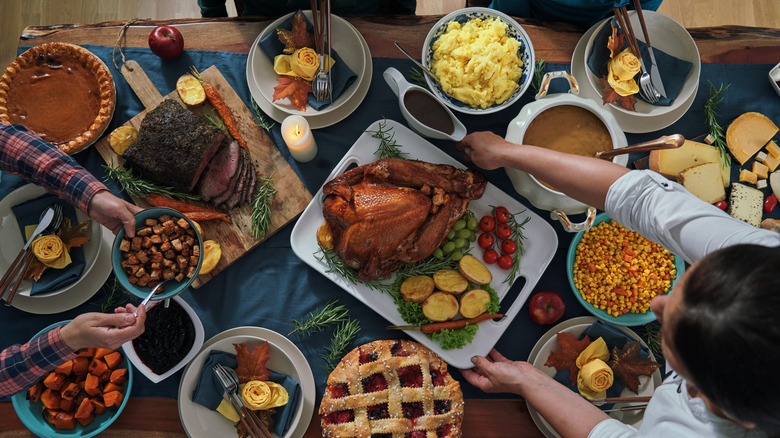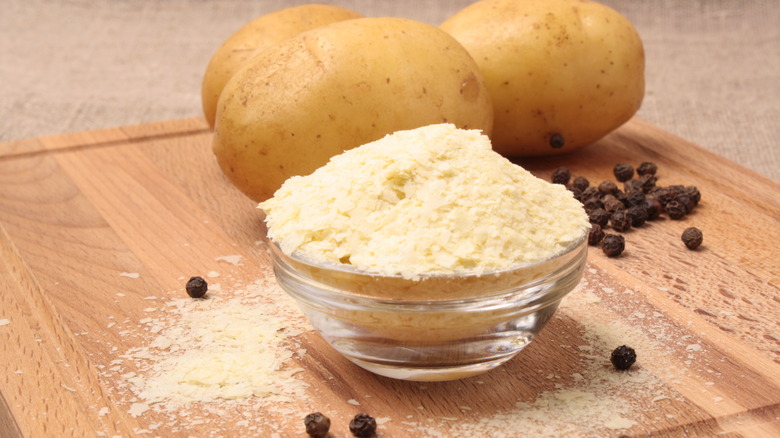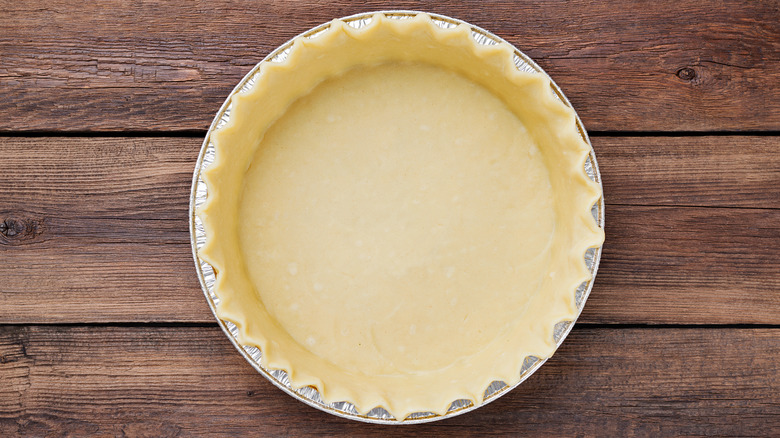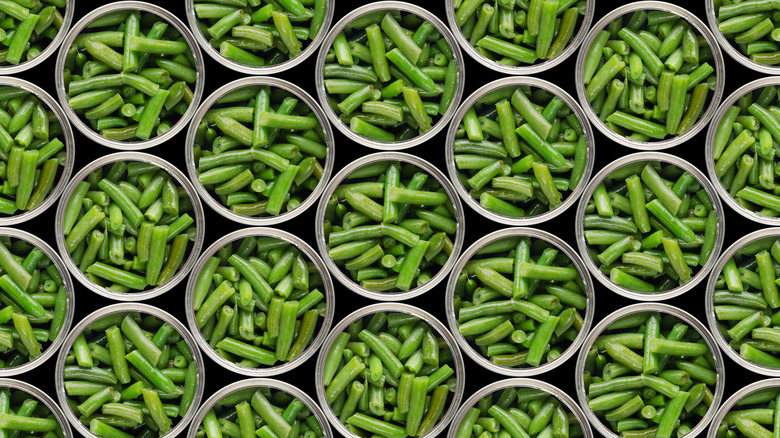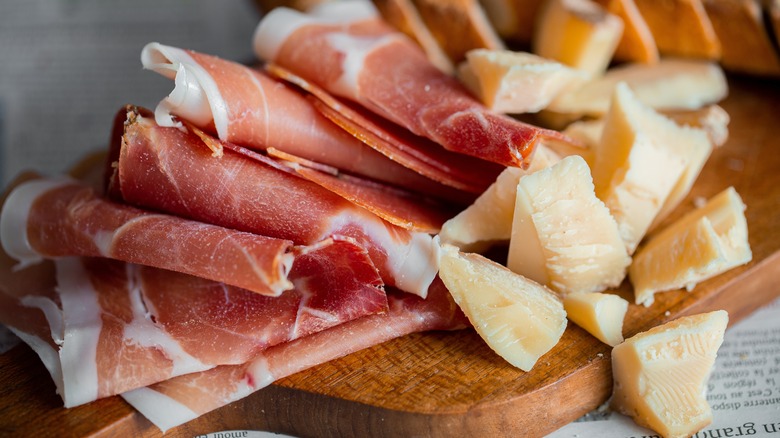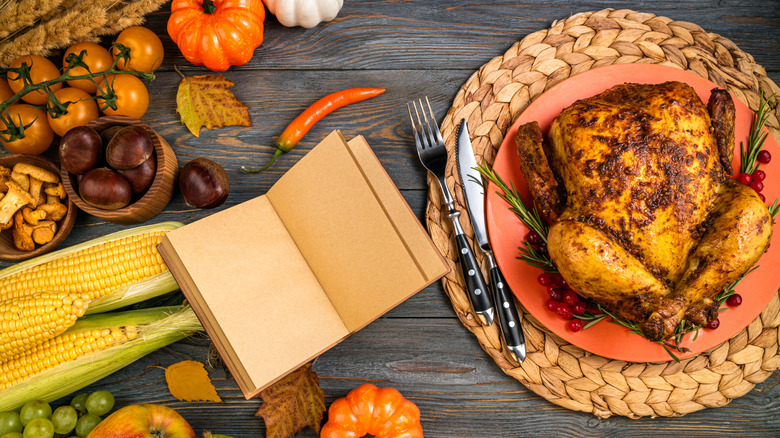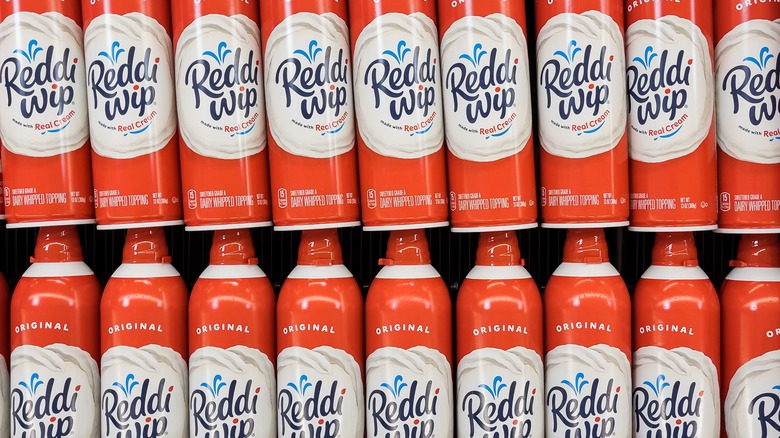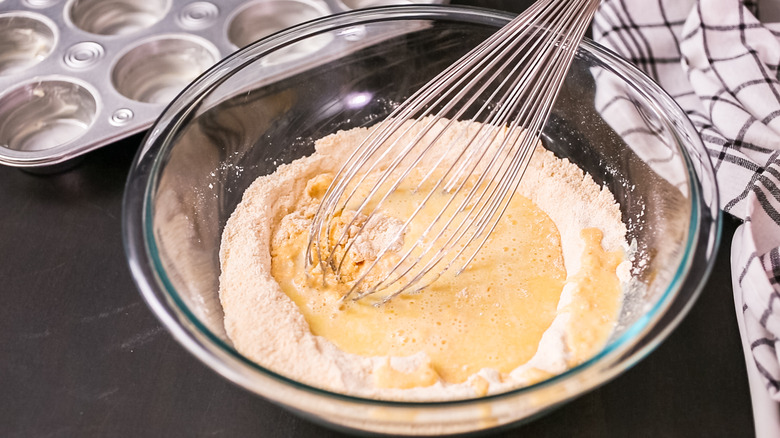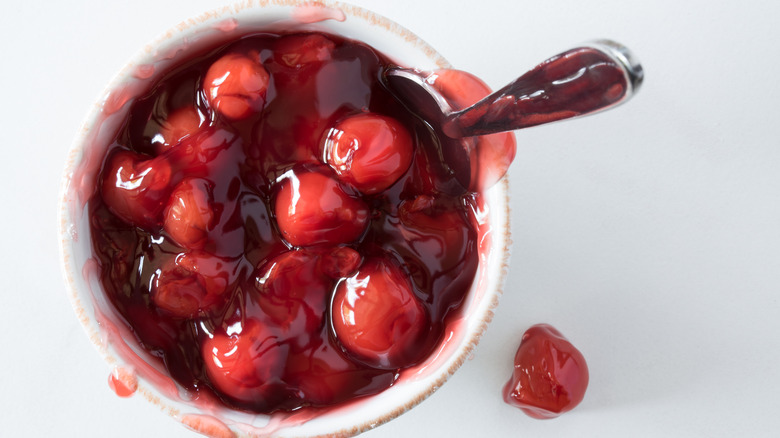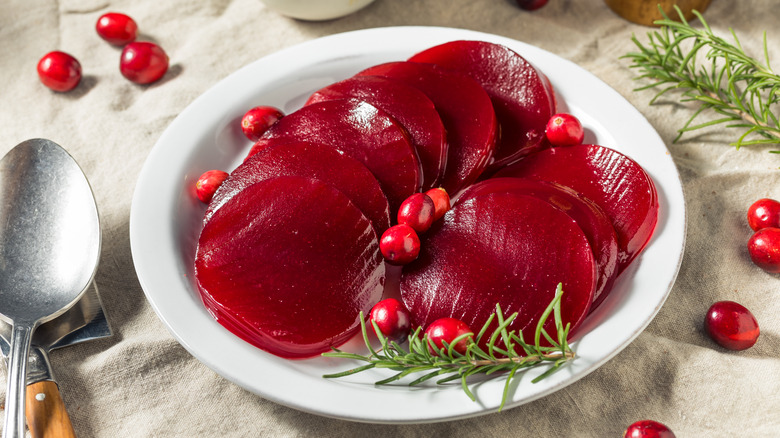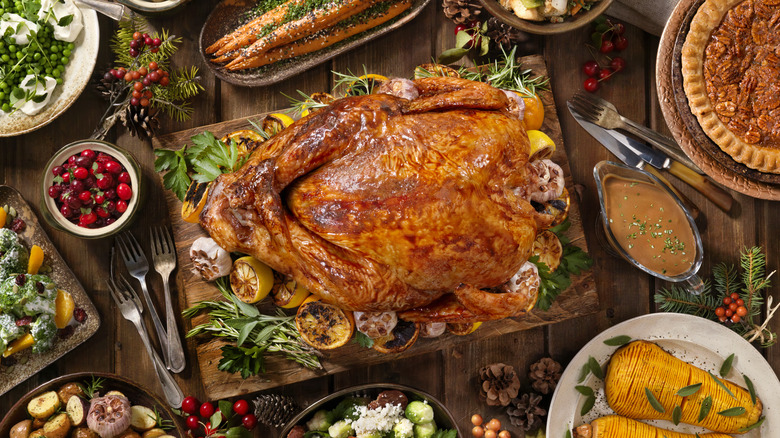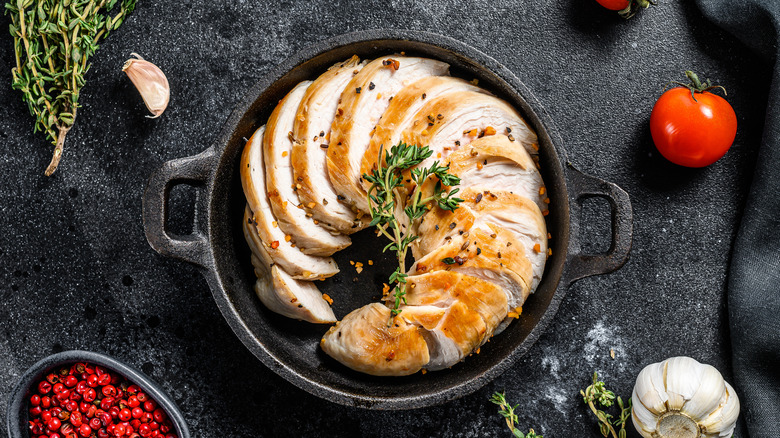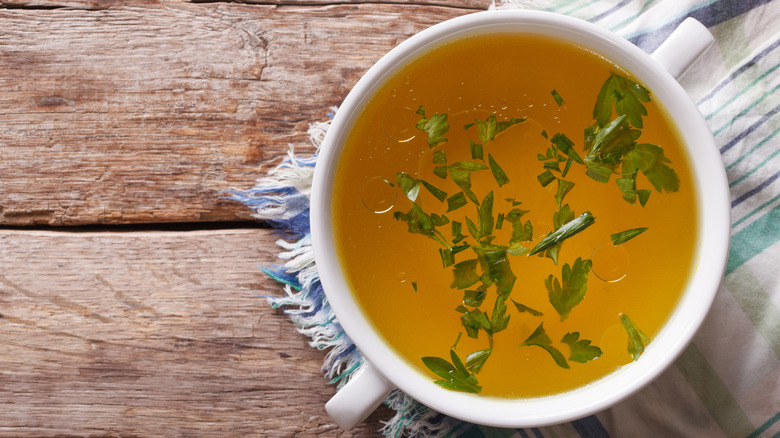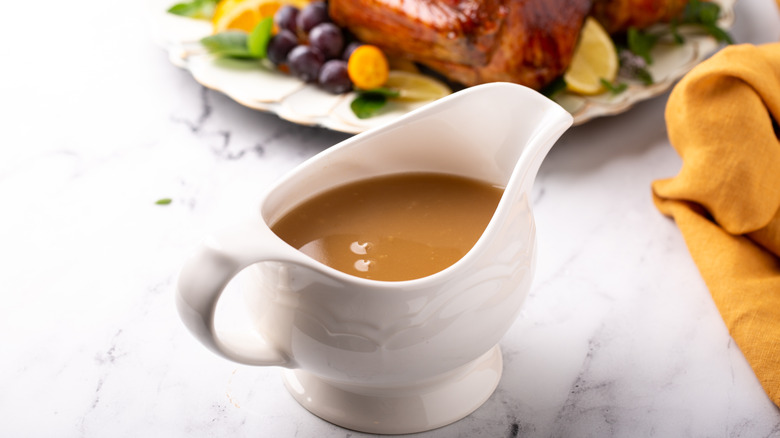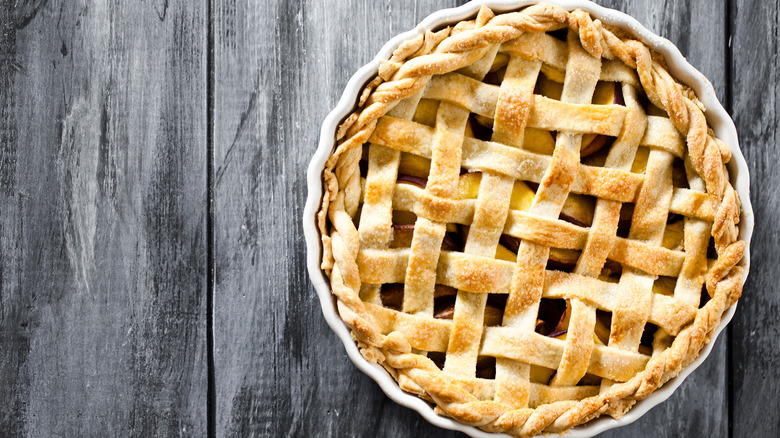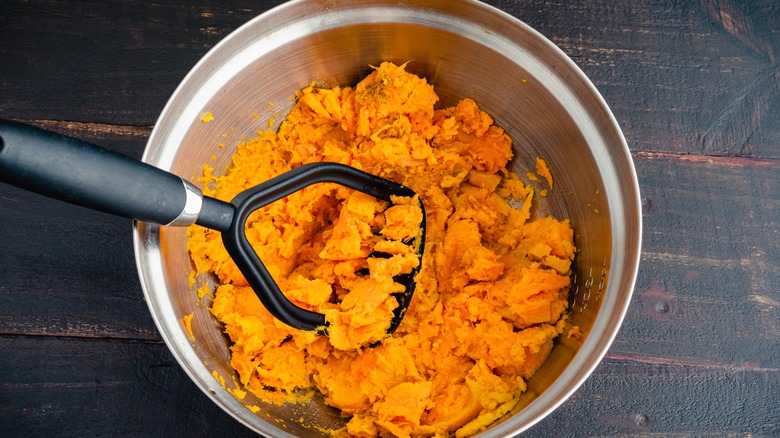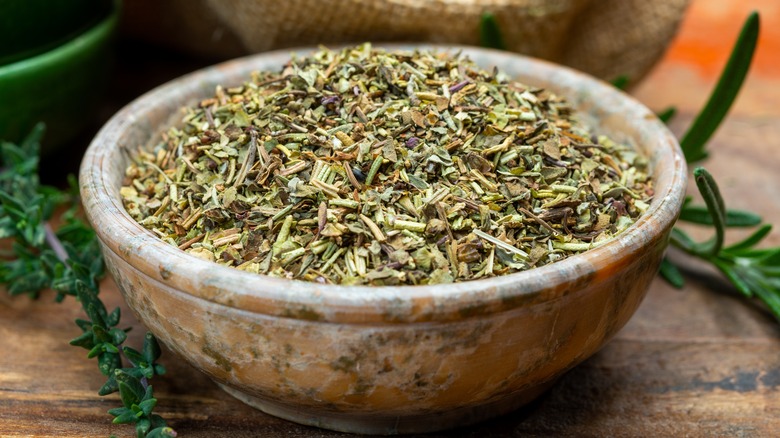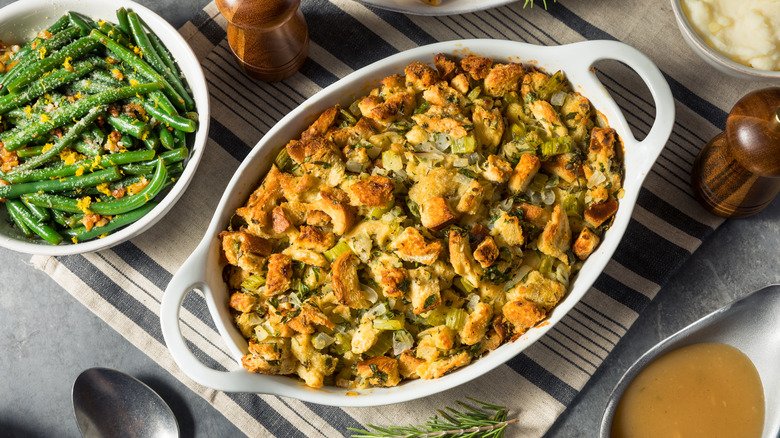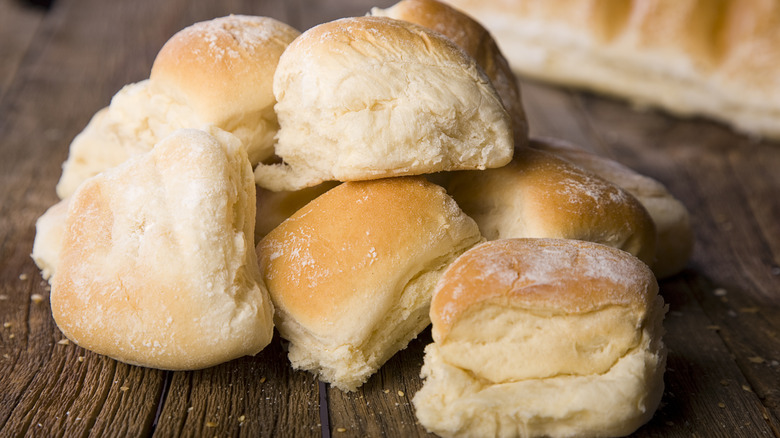9 Thanksgiving Short Cuts That Aren't Worth It And 9 That Are
Thanksgiving, for some people, is simultaneously the happiest and most stressful holiday of the year. It's a happy occasion because you get to spend it with family and friends, expressing gratitude, and eating plates of delicious food. But it's stressful because the amount of preparation that can go into making the meal is frankly wild.
While Thanksgiving dinner can be as basic or as complicated as you want it to be, the average meal consists of a combination of turkey, mashed potatoes, stuffing, gravy, cranberry sauce, and pie. This is all before you consider any snacks or hors d'oeuvres, salads, green bean dishes, and drinks you might be serving.
It's little wonder that people generally lose sleep around Thanksgiving due to stress. According to a survey from the Sleep Foundation, the people who are hosting snooze almost an hour less, on average. There's a lot of stuff to consider and a lot of recipes to make. But while it can feel immensely gratifying to cook a Thanksgiving dinner from scratch, you may not actually need to. There's a range of shortcuts you can take around Thanksgiving which will save you from losing your hair. Your guests won't even know the difference. However, some shortcuts are best left avoided.
Not worth it: Using instant mashed potatoes
Mashed potatoes might be a simple dish, but they're far from effortless. Making mashed potatoes is a multi-stage process, one which involves cubing your potatoes, boiling them, and utilizing some serious arm strength to whip them into shape. It's this last step which is perhaps most annoying on Thanksgiving — the more time you spend mashing by hand, the less time you have to do anything else.
But choosing instant mashed potatoes as a workaround for this is unwise. "Consumers should be wary of making these a common addition to their meals over whole potatoes," nutritionist Lisa Richards tells Mashed, due to their sodium content. The average box of instant mashed potatoes is laden with salt, with just a one-third cup having approximately 440 milligrams of sodium — a hefty proportion of your daily allowance. Furthermore, Richards explains that: "These potatoes will be seasoned further with salt and butter which will drive up the sodium content further." Richards also explained that the suggested serving size is not what most people will actually end up eating.
Additionally, instant mashed potatoes are often full of additives and preservatives and are far more calorie-dense than using regular potatoes. But the main reason to avoid them really comes down to taste. Instant mashed potatoes often have a flat, curiously artificial flavor, which will feel out of place on your plate of homemade food.
Worth it: Buying a store-bought pie crust
No Thanksgiving is complete without a pumpkin pie, but these baked goods can be time-consuming and challenging to make from scratch. Too often, homemade pie crusts can end up shrunken, have soggy bottoms, or are too brittle, ruining your dessert. Save yourself the stress and buy a store-bought pie crust. Doing so takes a huge amount of stress and prep work out of the day, leaving you to focus on making your filling the best it can be.
Using store-bought pie crusts on Thanksgiving has been endorsed by celebrity chef Ina Garten, who finds that using one can actually produce a better result than making your own. The lightness of store-bought pie crust allows the dense, creamy fillings to shine. There shouldn't be any shame around using one, Garten told The New York Times: "I think just for Thanksgiving, all bets are off. Whatever you need to do to get Thanksgiving dinner on the table is OK." For a top tip, use a fork to crimp the sides of your pie crust. This will make your pie look even more rustic.
Not worth it: Using canned green beans for your casserole
Green bean casserole supplies a welcome pop of greenery on a Thanksgiving table. It's a vegetable side dish that offsets some of the richer elements of this filling meal. But green bean casserole can quickly turn into mush. One of the main reasons this happens is that many folks use canned beans.
While this can seem like a time-saver, canned green beans are often well-cooked before being sealed. When you cook them again in a casserole, they end up disintegrating. They can get even softer in the can, thanks to being packed in salty brine, which also raises sodium levels.
Instead, it's far better to use frozen or fresh green beans. Frozen green beans are perfect for green bean casserole, as they require far less prep work. They are already trimmed and blanched before being frozen, so you can use them pretty much straight away. Of course, they're also firmer than canned green beans usually are. You can use as many or as few as you'd like, eliminating the issue of having to figure out what to do with a leftover half-can of beans. Fresh green beans will likely provide the most vibrant flavor for a casserole, but bear in mind that they'll need preparing and cooking, before being used in your recipe.
Worth it: Getting store-bought appetizers
Appetizers do far more than just keep people out of the kitchen during Thanksgiving. They also serve as a gateway to the meal, introducing your guests subtly to the flavors to come, and preparing them for the massive meal ahead. According to a study published in Cell Metabolism, appetizers are, in fact, appetizing, with the start of eating causing hunger receptors to turn on. This means that the appetizers you're serving at your Thanksgiving meal may actually help your guests enjoy their meal even more.
But there's no need to stress yourself out making appetizers. Store-bought ones are not only a time-saver, but they give you the space to focus on making the main meal just right. There's no need to try and reinvent the wheel, either. "Stick to simple cured meats, salami, cheese boards and perhaps a fruit plate with good nuts," chef Maro Gjurasic told HuffPost. Author and fellow chef Jake Cohen, on the other hand, keeps things even simpler, advising that pigs in a blanket and ready-made dips will work just fine.
Not worth it: Assuming you know the recipe
If you're accustomed to making Thanksgiving dinner every year, you might know some of your recipes like the back of your hand — or so you think. It's worth remembering that many Thanksgiving meals contain elements or seasonings that we don't use very often. Assuming you know the recipe, and forgetting to check the recipe beforehand may leave you caught short on the big day. Checking your recipes beforehand also allows you to designate the pots and utensils you'll need for each dish, figure out your timings, and assess whether any of the ingredients you're using will be unsuitable for the dietary requirements of your guests.
Our top tip is to read all your recipes a few days before the big day, then do a stock check to make sure that you have everything you need. Also, check the quality of any of the dried herbs and spices you're going to be using. Pantry staples like these can lose their potency, so test them by rubbing a small quantity in your hand, and checking that the scent it releases is still strong. If it isn't, you'll need to buy a fresh batch.
Worth it: Buying store-bought whipped cream
Making your own whipped cream isn't exactly difficult, but it can be time-consuming — and perhaps most annoyingly, it can take up a lot of space. Not only do you have to use valuable fridge real estate with potentially large tubs of cream, but you also have to designate a large part of your countertop to your stand mixer. If you're opting to do it by hand, you'll expend time and energy that is better used elsewhere.
Save yourself the trouble and buy some whipped cream. Many canned whipped cream brands have refreshingly short ingredient lists. The majority of products contain little more than cream, skim milk, and a few flavorings. There are also sugar-free options out there that won't break the bank, such as Walmart's Great Value Sugar-Free Whipped Heavy Cream.
Let's be honest, folks: There's also a lot of fun to be had by squirting whipped cream from a can onto your plate, and that's not to be underestimated, especially if you have kids dining with you.
Not worth it: Opting for cornbread mix
Cornbread is a traditional component of Thanksgiving. It offers a mild, subtle flavor that offsets the sharper tastes of gravy and cranberry sauce excellently. While making cornbread isn't too difficult, some people still go for ready-mixed box versions, which promise more ease and flavor.
The problem with these cornbread mixes, though, is that they're generally swimming in additional ingredients that you might not want in your food. Betty Crocker Cornbread and Muffin Mix, for example, has 10 grams of added sugar per serving. It also contains corn syrup and a good amount of sodium. Some cornbread mixes also get their fat from hydrogenated lard, which may contain trans fats that can have a negative impact on your cholesterol levels, according to Medical News Today.
Making your own cornbread from scratch, on the other hand, allows you to control the ingredients that go into your dish. As cornbread mixes usually require additional ingredients (like eggs and milk) you're not actually saving that much time or effort by buying them, and you likely won't save that much money either.
Worth it: Using canned pie fillings
On paper, it might not seem like a good idea to entrust your dessert to the contents of a can. But some canned pie fillings can provide a surprising bang for your buck. "Pie fillings are sort of like Hershey's syrup. If they're done right, why make your own?" chef Maro Gjurasic told HuffPost. Canned fruit pie fillings can save you the hassle of boiling down fruit mixtures into syrup, which can be lengthy and somewhat challenging for novice chefs. They can also save crucial space in your fridge or cupboards, which could be used more wisely.
Chef Jake Cohen agrees, but includes a caveat: "If buying the fillings means you're going to make your own crust, then I don't mind." You might want to consider making one part of your pie homemade, so it has somewhat of a homey feel to it. It's also worth remembering that some canned pie fillings can be very high in added sugars. If possible, look for pie fillings that are low in sugar.
Not worth it: Picking up some canned cranberry sauce
Of all the things that you might be buying canned during the holiday season, cranberry sauce is one of the most common. But it's best left on the shelf. Canned cranberry sauce is often astonishingly sweet, ruining both its taste and its nutritional value.
"I find canned cranberry sauce to taste cloyingly sweet and over-processed," says Institute of Culinary Education chef Seamus Mullen told Mashed. This sweetness comes from a frankly enormous amount of added sugar, much of which comes from high fructose corn syrup — an ultra-sweet additive that's been linked to higher levels of obesity, liver disease, and type 2 diabetes, according to WebMD.
Registered dietitian Emily Wunder points out that in some canned cranberry sauce brands, there are 24 grams of added sugar per serving. According to Harvard, this is the maximum amount that women are recommended to consume daily. As well as this, you're also potentially getting a load of additives and preservatives that you may not want. At the end of the day, homemade cranberry sauce often tastes better. By limiting the sugar you put in it, you can better enjoy the health benefits of the cranberries themselves — which are full of antioxidants, according to Livestrong.
Worth it: Skipping stuffing your turkey
Stuffing started life way back in the first century AD, as a mixture that was stuffed into various different kinds of meat. In more modern times, it's usually served baked on its own, spooned onto the plate alongside everything else. But if you're tempted to cook it like they used to in the old days — by stuffing it into your turkey and avoiding using up a precious casserole dish — we wouldn't.
Cooking stuffing inside your turkey can extend the time that your bird takes to cook. Additionally, using this method may potentially raise the risk of food poisoning. Both your turkey and your stuffing need to reach a minimum temperature of 165 degrees before it's totally safe to eat, according to SELF. But if you stuff your turkey too much, you limit the ability of heat to get through it properly, potentially leaving parts of it undercooked. You're far better off just cooking the stuffing separately.
Not worth it: Buying precooked turkey
The turkey is the star of the show at Thanksgiving, but it's also the thing that takes by far the longest to cook. A 12 to 14-pound turkey can take three or more hours to cook. While the turkey is cooking, it can dominate the space in your oven. The bird is also notorious for being somewhat tricky to get just right, often leaving you with dry, tough meat that needs copious amounts of gravy.
We can understand the arguments for skipping all of this time, effort, and potential stress, and buying precooked meat. But trust us when we say that you shouldn't. "The thing about cooked birds in stores is that they're a bit overcooked and dry," chef Mary Attea tells HuffPost. You might end up inadvertently ruining the best part of the meal.
It's worth remembering that a bronzed turkey, lovingly cooked in the oven and then carved at the table, is an integral part of the experience of Thanksgiving. If you're nervous about getting your turkey right, chef Maro Gjurasic recommends opting for a smaller one. They're far harder to undercook, and you still get that wow factor.
Worth it: Using store-bought chicken broth
Chicken broth is one of those ingredients that you'll need on hand at Thanksgiving. It plays a vital part in making gravy. It can also be used to add quick flavor to a host of other dishes, like mashed potatoes, green bean casserole, and soup. But making your own is more hassle than it's worth. Unless you have any previously-made tubs stashed in your freezer, making fresh chicken broth takes a while, requiring multiple ingredients and likely making a lot of mess.
Store-bought chicken broth, on the other hand, takes a matter of moments. All you need to do is dissolve a cube in some hot water or heat it up in the microwave. Store-bought chicken broths often supply great flavor, as well as provide more broth for your buck. It's important to remember, though, that some store-bought chicken broths are high in sodium, which can make your food taste very salty. Try to find low-sodium options, and adjust the salt level to your liking.
Not worth it: Utilizing store-bought gravy
There's no denying that store-bought gravy is ultra-convenient. It saves you from having to do one final, annoying job at the very end of your marathon cooking process. But the fact is that it just doesn't compare to the homemade stuff. Gravy is the unifying dish that goes across all of our foods at Thanksgiving. When you make your own, you're using all of those delicious meat juices that have dripped from the turkey to create a sauce with deeply savory, layered flavors.
This not only cuts down on food waste but also gives you the freedom to make as much as you like. You're not limited by the amount you get in a tub or a sachet. There's also the sodium content to consider. Some turkey gravy mixes can be very salty: Walmart's Great Value Turkey Gravy Mix, for example, supplies 16% of your sodium daily value in one serving. Homemade gravy, on the other hand, gets its flavor from a range of different seasonings, not just salt.
Worth it: Getting a pre-made apple pie
There's no denying that a homemade apple pie is immensely comforting. But it can also be the part of the meal that tips you over the edge, stress-wise. Store-bought apple pies are reliable and delicious, and most people still enjoy them. Besides, there are usually several pies and desserts floating around during a Thanksgiving meal, and no one will begrudge you if your apple-flavored one is bought from a supermarket if most of the other dishes on the table are made fresh.
A frozen apple pie is also a great choice if your fridge is bulging with other food. The good news is that these days, there are loads of frozen pies that taste pretty close to homemade. Sara Lee's Dutch Apple Pie uses a streusel topping, which gives it a rustic appearance and a delicious crunch. The crust is robust yet flaky, and the apples stay firm when cooked and don't disappear into mush. The best part is that it won't break the bank — whereas if you're making one from scratch and you're not a regular baker, you may end up spending copious amounts on new ingredients and cooking equipment.
Not worth it: Omitting eggs from your sweet potato casserole
Eggs don't turn up in every sweet potato casserole dish. But unless you have people at your table who can't eat eggs, we highly recommend cracking one in. Eggs supply a useful binding effect to a dish, making the whole thing come together more effectively. They also help to add volume and bulk out the casserole. This will help make the dish taste richer, while providing it with some useful additional protein, too.
Just remember that adding an egg can make your dish more hazardous — as undercooked eggs can cause food poisoning. To ensure that it's safe to eat, your casserole needs to have an internal temperature of 165 degrees Fahrenheit, at which any harmful bacteria is killed off. The best way to check for this is with an internal probe thermometer, which gets inserted into the center of the dish. If you don't have one, look out for a slight rise around the outer edge of the casserole.
Worth it: Using dried herbs instead of fresh ones
Hosting Thanksgiving is expensive. It's important to cut costs wherever you can. One place where you can save serious money is by skipping fresh herbs and using the dried ones already in your pantry.
A jar of dried herbs is generally around the same price, or cheaper, than fresh herbs. Dried herbs can also provide a similar flavor to your dishes. In fact, dried herbs have a more intense flavor than fresh ones, so you can use less and get the same result. Additionally, the herbs that are generally used most commonly in Thanksgiving food — like thyme, rosemary, and sage — are robust and tasty when dried. Just make sure that you're adding dried herbs early on in your recipe, so the flavor has time to infuse into your dish properly. Doing so also gives them time to soften, so you're not biting into a brittle, chalky herb.
Not worth it: Using fresh bread for stuffing
Not everyone has the time to prepare for a Thanksgiving meal days in advance. Preparing bread for stuffing — by slicing it and letting it go stale a few days before you cook it — can feel like unnecessary work. But if you skip this step and use fresh bread, you'll find that it's far more absorbent. Stale bread can more easily take moisture from your eggs and chicken broth. This will leave your stuffing soggy, sloppy, and sad.
Have the foresight to give your bread time to go stale. Freshly-baked bread usually takes a few days to harden up, whereas store-bought loaves may take longer. The best thing to do is leave it out on the counter, where it has ready access to air, allowing the moisture to seep to the surface and out of the dough. If you've totally forgotten to do this, a good trick is to place your sliced bread in a low oven for around half an hour. Once you remove it and let it cool, it should dry right up.
Worth it: Buying store-bought bread rolls
If you're able to battle through the millions of dishes that a Thanksgiving meal involves — and still somehow have time to make fresh bread rolls — we salute you. But for everyone else, feel free to use store-bought rolls. Freshly-made bread rolls may be delicious, but they're just way too much work at Thanksgiving — especially when there are so many good varieties out there. Many supermarkets have in-store bakeries that make their rolls fresh every day, and it's simple to pick up a bag of them when grabbing your other items.
If your local store doesn't have this, companies like King's Hawaiian make excellent prepackaged rolls. The company's Original Hawaiian Sweet Rolls have a sweetness to them that offers an excellent balance to the other flavors on your plate. If you want the best of both worlds, grab some ready-made dough to bake at home. Companies like Pillsbury sell canned biscuit dough that can be bought weeks in advance, and stored in the freezer until you're ready to use it. When baked, it produces a fresh result that tastes just as good as homemade.
